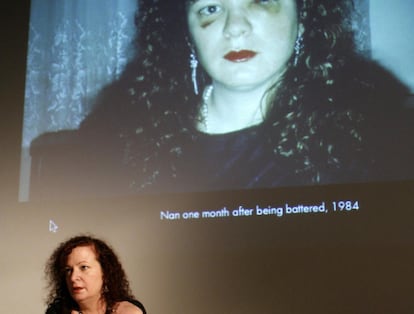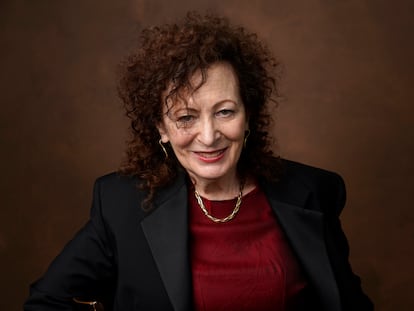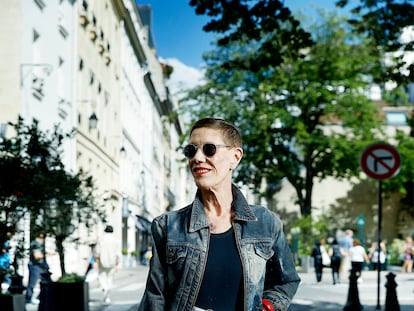Nan Goldin: ‘What makes it radical are all these men trying to stop it from coming to light’
Laura Poitras’ documentary ‘All The Beauty and The Bloodshed,’ explores the work of the queer feminist and anticapitalist artist

The legendary photographer Nan Goldin says, “It’s easy to make your life into stories. But it’s harder to sustain real memories.” That’s why she has spent her life creating hyperrealistic photos that look like stage sets. But she knows that “real experience has a smell and is dirty and is not wrapped up in simple endings.” Laura Poitras’ documentary about Goldin is now available to view on streaming platforms. Why should you watch it?
Because it’s feminist
In 1985, Nan created The Ballad of Sexual Dependency, a photo series about the struggle between autonomy and dependency and the power relationships between men and women that put her in danger. The artist’s visibility grew, and she photographed herself with her face wounded by her boyfriend’s punches. He couldn’t stand who she was and what she saw. “My photos in which I look battered were what prevented me from returning,” she says. Many women in her situation were able to talk about it because they saw the photos. I haven’t found Nan to define herself as a feminist, nor Laura, but the only seconds in the film in which they speak as a duet take place when Nan says that when her boyfriend tried to destroy her eyes with his fists, at least she didn’t have the “ballad” slides on her screen — and here comes the double take: “Because he would have destroyed them.” The artists both say. The women who know that their eyes are their voice speak.
Because it’s queer
The first gallery owner who bought work from Nan explains that he “had never seen photos like those, portraits of people living their lives that were unlike anything anyone else was doing.” He refers to photos, but also to lives: to the memories of the transvestites, the lesbians, the badasses, the hedonistic lumpen and the chosen family of the artist at the epicenter of the 1980s in New York. The photos are full of light and sequins and laughter and speed, and they form brilliant memories that don’t smell as bad as they should, as Leslie Feinberg has said.
They may seem like photos of outcasts, but Nan says, without flinching, that “normal people were the outcasts for us.” Perhaps that is the political statement that explains all of her art. Nan took photos of her world without realizing that it was an eccentric world. She sought to remember her life as she saw it. The very act of existing was already political. Photographing it was revolutionary. Reading it as art was subversive.
Because it criticizes the family, private property and the state
Laura Poitras portrays the Nan Goldin of today, walking through a transformed New York, saying that “the rich are afraid that we will dig until we find the evil ways they made their money.” Nan continues taking photos. Now she is determined that museums, galleries and universities erase the Sackler surname from their walls: the family became rich by creating the United States’ epidemic of prescription opiate addiction, resulting in more than half a million deaths. The artist, who barely survived an Oxycodone overdose, managed to organize with a group of activists to force the cultural industry to erase from its walls the surnames of those who made money from other people’s deaths.
It is curious that the great supervillains of fentanyl addiction are a family. The family as a source of pain is a key subplot in the documentary, as it is in Nan’s life. “My parents were not prepared to have children,” she says.
Because of mental health
The documentary’s title is a phrase from a medical report on Goldin’s older sister, who was institutionalized for being an indomitable lesbian. The entire documentary, as well as all of Nan’s art, is a denunciation of normality, a silent dictatorship that drags those who do not surrender to the margins. Nan uses the portrait of her sister as a mirror. It is a constant presence in the documentary, because it is a documentary against the system.
Because it looks inward and upward
In 1989 Nan curated her first group exhibition, Witnesses. She reaffirmed her perspective on art as something that, if honest, can change everything. Cardinal O’Connor was scandalized by the exhibition, composed of artists living with HIV. In the documentary, David Wojranowicz laughs at the scandal: “It’s wonderful because it means that the control of information has a crack.” That’s what Nan Goldin and Laura Poitras do: create cracks in the beliefs that sustain the system. That’s why they talk about suicide, friendship, chosen family, public health, sex work, drugs, homophobia, death, memory rituals as political strategies, and the political roots of all their pain. Both use their own wounds to point out those who cause them, from the bed to the Capitol.
“Photography has always been my way of walking through fear,” says Nan. Perhaps that is the political statement that explains all art: “What makes the work even more radical are all those men trying to prevent it from coming to light.” If that sounds familiar to you, you have to see it.
Sign up for our weekly newsletter to get more English-language news coverage from EL PAÍS USA Edition









































